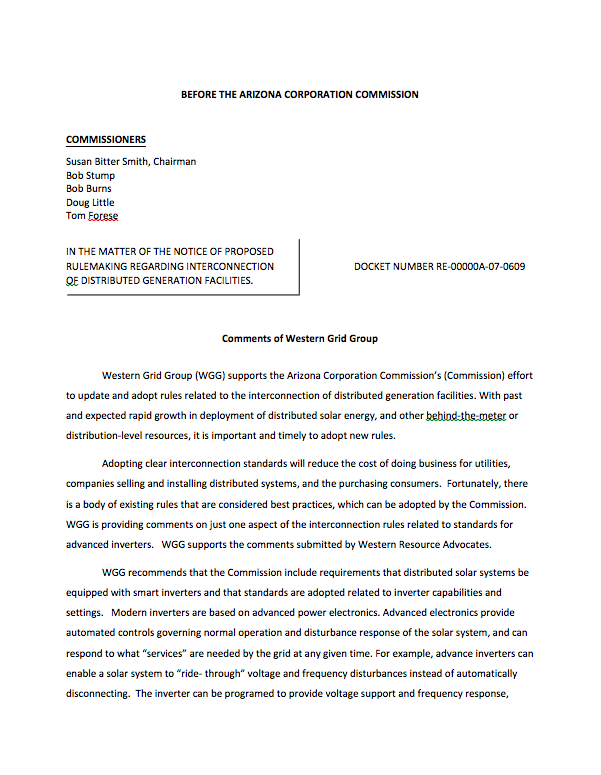Western Grid Group (WGG) submitted comments to the Arizona Corporation Commission’s on its effort to update and adopt rules related to the interconnection of distributed generation facilities. Comments were submitted July 24, 2015.
WGG supports Rule 21, Part 1 with its 7 setting specifications.
You can download comments HERE. (word doc)
BEFORE THE ARIZONA CORPORATION COMMISSION
COMMISSIONERS
Susan Bitter Smith, Chairman
Bob Stump
Bob Burns
Doug Little
Tom Forese
IN THE MATTER OF THE NOTICE OF PROPOSED
RULEMAKING REGARDING INTERCONNECTION DOCKET NUMBER RE-00000A-07-0609
OF DISTRIBUTED GENERATION FACILITIES.
Western Grid Group (WGG) supports the Arizona Corporation Commission’s (Commission) effort to update and adopt rules related to the interconnection of distributed generation facilities. With past and expected rapid growth in deployment of distributed solar energy, and other behind-the-meter or distribution-level resources, it is important and timely to adopt new rules.
Adopting clear interconnection standards will reduce the cost of doing business for utilities, companies selling and installing distributed systems, and the purchasing consumers. Fortunately, there is a body of existing rules that are considered best practices, which can be adopted by the Commission. WGG is providing comments on just one aspect of the interconnection rules related to standards for advanced inverters. WGG supports the comments submitted by Western Resource Advocates.
WGG recommends that the Commission include requirements that distributed solar systems be equipped with smart inverters and that standards are adopted related to inverter capabilities and settings. Modern inverters are based on advanced power electronics. Advanced electronics provide automated controls governing normal operation and disturbance response of the solar system, and can respond to what “services” are needed by the grid at any given time. For example, advance inverters can enable a solar system to “ride- through” voltage and frequency disturbances instead of automatically disconnecting. The inverter can be programed to provide voltage support and frequency response, which can help mitigate a disturbance and/or help the distribution system recover more quickly. In this manner of operation, solar and other distributed generation systems provide value to the distribution grid and flexibility for grid operators.
As more distributed solar systems are added to the distribution grid, there is concern about the individual and cumulative impact of solar systems on overall grid performance. In part, this is a result of current safety standards that require a photovoltaic system to disconnect from the distribution system when there is an electrical disturbance. When there is an electrical disturbance, a utility has to work to bring the system back into balance. If solar systems are required to disconnect during an electrical disturbance, utilities lose the power being generated from the solar systems, potentially making a disturbance or imbalance worse. So, requiring a distributed solar system to disconnect can be a double hit for grid operators. Advanced inverters now allow solar systems to avoid coordinated tripping off and further, to remotely adjust settings and be accurately controlled.
The Institute of Electric and Electronic Engineers (IEEE) is working on updating their 1547 standard related to Interconnecting Distributed Resources, but these standards are not expected to be completed and adopted for at least one year and likely several. High solar penetration states, like California, realized that deploying large amounts of solar without access to the advanced capabilities inherent in solar systems with advanced inverters, would create costly grid issues that can be avoided by developing protocol and standards for the operation of solar systems.
California is in the process of developing standards for smart inverters using an extensive collaborative process. The Smart Inverter Working Group (SIWG) has a three phase process to develop interconnection standards.
• Phase 1, approved by the California Public Utility Commission on December 18, 2014, established seven autonomous functions for advanced inverters .
• Phase 2 will develop protocols for communications between the grid operator and distributed energy resources.
• Phase 3 will address advanced inverter functionalities.
WGG recommends to the commission the approved portion of Rule 21 (phase 1) as a best practice for adoption in Arizona. The approved part of Rule 21 addresses the following:
a. Anti-Islanding Protection;
b. Low and High Voltage Ride-Through;
c. Low and High Frequency Ride-Through;
d. Dynamic Volt-VAR Operation;
e. Ramp Rates;
f. Fixed Power Factor; and
g. Soft Start Reconnection.
These standards are included in the California Energy Commission (CEC) rule (R.11-09-011) for regulated utilities. The working group that developed the standards included a broad range of stakeholders representing the state’s three regulated utilities, unregulated utilities, the solar industry, inverter manufacturers, CEC staff and other interested individuals.
Adopting these standards in Arizona as part of this rule development process will allow Arizona utilities to access the advanced capabilities available from solar systems now and avoid creating issues on the distribution system that could be costly to mitigate in the future. If Arizona waits for the IEEE 1547 standard to be updated and adopted, thousands of solar systems without grid friendly features could be deployed in the meantime. WGG recommends that the interconnection rule for regulated utilities adopt Phase 1 of Rule 21 as promulgated by the CEC no later than December 31, 2016. Further, WGG recommends the Commission provide for the opportunity to update the interconnection rule when IEEE 1547 has been updated and Rule 21 Phases 2 and 3 completed. Adopting accepted and vetted statewide requirements for Arizona now will provide uniformity and certainty for businesses, consumers and the electric utilities. A modernized standard will allow solar and distributed systems to provide grid support and valuable services to make the distribution system more modern and robust.
Further, standards for distributed energy resources is an evolving area which will require staff to monitor IEEE and CEC processes and adopts new standards as they are developed. Adopting best practice standards will allow the state to maximize the use of its indigenous energy resources.
Thank you for the opportunity to provide comments.
RESPECTFULLY SUBMITTED this 24th day of July, 2015.
Amanda Ormond
Managing Director
Western Grid Group
7650 S. McClintock Drive
Ste 103-282
Tempe, Arizona 85284
asormond@msn.com

